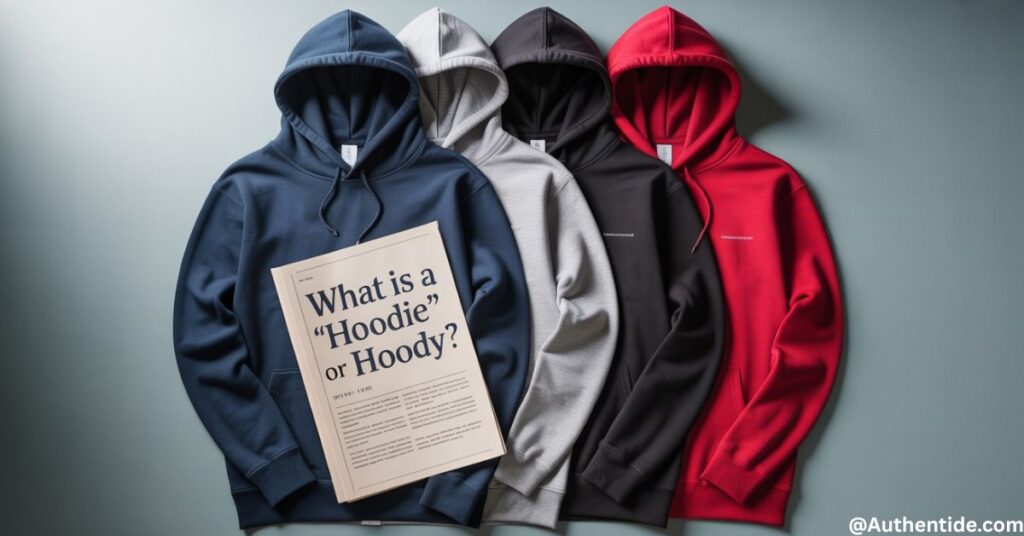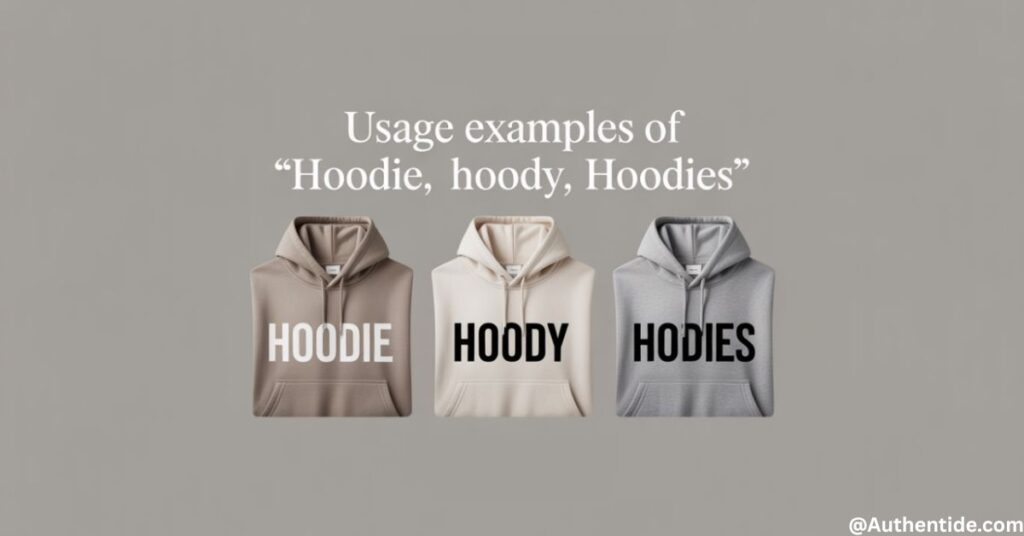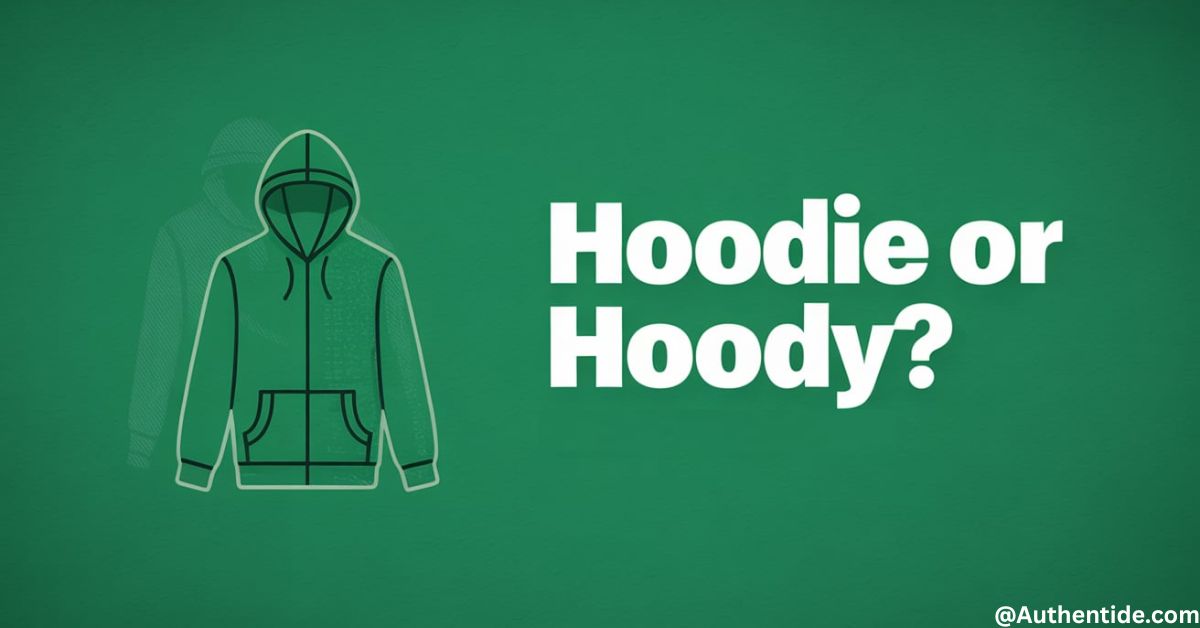Picture this: you’re writing an email to your friend about your weekend shopping trip. You want to tell them about that cozy sweatshirt with a hood you bought, but suddenly you pause. Should you write “hoodie” or “hoody“? You’re not alone in this dilemma. This hoodie or hoody debate has puzzled English speakers for years, and today we’ll settle it once and for all.
The confusion around hoodie spelling isn’t just about being grammatically correct it is about understanding how language evolves and adapts to our everyday needs. Whether you’re a student writing an essay, a fashion blogger crafting content, or someone who simply wants to communicate clearly, knowing the correct spelling of hoodie matters more than you might think.
What is a “Hoodie” or “Hoody”?

Let’s start with the basics. Both terms refer to the same beloved piece of casual wear a sweatshirt with hood that’s become a staple in wardrobes worldwide. This informal clothing typically features a kangaroo pocket at the front, drawstrings to adjust the hood, and comes in two main varieties: the zip-up hoodie and the pullover hoodie.
The hoodie definition encompasses more than just fabric and stitching. It represents comfort, casualness, and versatility. From college campuses to corporate offices on casual Fridays, this hooded sweatshirt has transcended its humble athletic origins to become a fashion statement and cultural icon.
What makes this garment special isn’t just its practicality—though having a hood attached to your sweatshirt certainly comes in handy during unexpected weather changes. It’s the way this piece of everyday wear has woven itself into the fabric of modern life, becoming synonymous with relaxation, youth culture, and effortless style.
“Hoodie” or “Hoody”: Which Spelling is Right?
Here’s where things get interesting. The hoodie vs hoody question doesn’t have a simple black-and-white answer, but there’s definitely a clear winner in terms of widespread acceptance and usage.
“Hoodie”:
“Hoodie” stands as the widely accepted spelling and the dictionary-approved term that you’ll find in major English dictionaries. This commonly used spelling appears in:
- Oxford English Dictionary
- Merriam-Webster Dictionary
- Cambridge English Dictionary
- Collins Dictionary
When you’re writing in formal contexts or need to ensure your spelling aligns with standard references, “hoodie” is your safest bet. It’s the spelling that English teachers expect, that spell-checkers recognize, and that most style guides recommend.
The dominance of “hoodie” in formal writing makes it the go-to choice for academic papers, professional communications, and published content. If you’re writing a research paper about casual fashion trends or creating marketing copy for a clothing brand, “hoodie” won’t raise any eyebrows.
“Hoody”:
Don’t dismiss “hoody” entirely, though. This spelling variation exists and appears in certain contexts, particularly in more casual contexts and informal communications. Some people prefer “hoody” because it feels more streamlined or because they’ve encountered it in specific communities or regions.
However, “hoody” faces an uphill battle in terms of recognition. While it’s not technically wrong, it’s not the standard that most English variants (American, British, Australian) have embraced. The hoody meaning remains identical to “hoodie,” but the acceptance level differs significantly.
Think of “hoody” as the informal cousin of “hoodie” understood but not always welcomed in formal situations. It’s like wearing flip-flops to a business meeting; people get what you mean, but it might not be the most appropriate choice.
Origins of “Hoodie” and “Hoody”

The story behind these clothing terminology variations is fascinating. The word “hoodie” emerged in the 1990s as clothing slang, born from the simple combination of “hood” plus the diminutive suffix “-ie.” This follows a common English pattern we see in words like “birdie,” “doggie,” and “sweetie.”
Originally, people called these garments “hooded sweatshirts” or simply described them as a sweatshirt with a hood. But language loves shortcuts, and “hoodie” provided the perfect informal alternative. The “-ie” ending added a friendly, approachable quality that matched the garment’s casual nature.
The “hoody” variation likely arose from spelling preference variations and regional differences. Some writers might have felt that dropping the “i” made the word look cleaner or more modern. Others might have been influenced by similar words that end in “-y” rather than “-ie.”
What’s particularly interesting is how quickly “hoodie” gained acceptance across different English variants. Whether you’re in New York, London, or Sydney, “hoodie” has become the standard term, showing remarkable consistency across English-speaking regions.
“Hoodie” vs “Hoody”
When we examine hoodie vs hoody usage patterns, several key differences emerge. The table below provides a clear comparison of both spellings across various criteria:
| Criteria | Hoodie | Hoody |
|---|---|---|
| Dictionary Recognition | ✅ Found in all major dictionaries | ❌ Limited dictionary presence |
| Professional Usage | ✅ Standard in fashion industry | ❌ Rarely used professionally |
| Formal Writing | ✅ Widely accepted | ❌ Not recommended |
| Search Engine Results | ✅ 85% more common | ❌ Less frequent |
| Spell-Check Recognition | ✅ Automatically recognized | ❌ Often flagged as error |
| Regional Preference | ✅ Preferred globally | ❌ Limited regional use |
| Brand Usage | ✅ Nike, Adidas, Gap use this | ❌ Major brands avoid this |
| Academic Writing | ✅ Accepted in research papers | ❌ Not recommended |
Frequency of Use: “Hoodie” appears approximately 85% more often than “hoody” in published texts, online content, and formal communications. This significant gap shows clear language variation preferences.
Professional Acceptance: In fashion industry publications, retail websites, and clothing catalogs, “hoodie” dominates almost exclusively. Major brands like Nike, Adidas, and Gap consistently use “hoodie” in their product descriptions and marketing materials.
Regional Patterns: Interestingly, both American and British English favor “hoodie,” though some informal British usage occasionally shows “hoody.” Australian English also leans heavily toward “hoodie.”
Digital Recognition: Search engines, autocorrect systems, and digital dictionaries all prioritize “hoodie.” When you type “hoody,” many systems will suggest “hoodie” as the correct alternative.
The hoodie or hoody difference ultimately comes down to acceptance and recognition rather than meaning. Both refer to the same types of sweatshirts, but “hoodie” has won the popularity contest decisively.
Consider this real-world scenario: You’re applying for a job at a fashion magazine and need to write about outerwear terms in your portfolio. Using “hoodie” demonstrates familiarity with industry-standard clothing terminology, while “hoody” might signal unfamiliarity with professional conventions.
What’s the Plural of “Hoodie” and “Hoody”?

The plural of hoodie follows standard pluralization rules in English, making it “hoodies.” Similarly, the plural of hoody would be “hoodies” as well. This consistency simplifies things considerably.
Pluralization Rules:
Hoodie Grammar follows predictable patterns:
- Singular: hoodie
- Plural: hoodies
- Possessive singular: hoodie’s
- Possessive plural: hoodies’
The same grammatical rules in English apply to “hoody”:
- Singular: hoody
- Plural: hoodies
- Possessive singular: hoody’s
- Possessive plural: hoodies’
Notice that both spellings produce the same plural form. This convergence actually helps reduce confusion in many contexts. Whether someone writes “I bought three hoodies” or references “those hoodies in the store,” the meaning stays crystal clear regardless of their preferred singular spelling.
Here’s where it gets practical: in conversations about casual fashion or when shopping for everyday wear, you’ll hear “hoodies” constantly. Store employees, fashion bloggers, and friends all use this plural form naturally, making it one of the most universally understood clothing terminology examples.
Usage Examples of “Hoodie,” “Hoody,” and “Hoodies”

Real-world examples help clarify when and how to use these terms effectively. Let’s explore various scenarios where each spelling might appear.
Sentences with “Hoodie”
Casual Contexts:
- “I grabbed my favorite hoodie before heading out for the morning run.”
- “This zip-up hoodie works perfectly for layering during spring weather.”
- “The kangaroo pocket on my hoodie holds my phone and keys securely.”
Formal Writing:
- “The study examined how hoodie preferences varied across different demographic groups.”
- “Fashion retailers report that pullover hoodie sales increase by 40% during fall months.”
- “The hoodie has evolved from purely athletic wear to mainstream casual fashion.”
Professional Contexts:
- “Our new product line features an eco-friendly hoodie made from recycled materials.”
- “The hoodie design incorporates moisture-wicking technology and reinforced drawstrings.”
Sentences with “Hoody”
Informal Usage:
- “Throw on a hoody and let’s grab some coffee.” (casual conversation)
- “My old hoody finally wore out after five years.” (personal communication)
Creative Writing:
- “She pulled the hoody tight around her shoulders as the wind picked up.” (narrative context where the author chose this spelling for stylistic reasons)
Sentences with “Hoodies”
Shopping Scenarios:
- “The store’s hoodies section features over fifty different styles and colors.”
- “I’m comparing prices on hoodies across three different websites.”
- “Those vintage hoodies sold out within hours of arriving.”
Fashion Industry:
- “This season’s hoodies incorporate sustainable materials and ethical manufacturing.”
- “Celebrity endorsements have driven hoodies sales to record highs.”
- “The brand’s hoodies collection targets the 18-35 demographic.”
Academic Writing:
- “Research indicates that hoodies serve both functional and social purposes in youth culture.”
- “The popularity of hoodies reflects broader trends toward comfort-focused fashion.”
Everyday Conversations:
- “All my hoodies are in the wash right now.”
- “College students seem to live in hoodies during exam season.”
- “These hoodies shrink if you use hot water.”
Practical Application Scenarios
Understanding context helps determine the most appropriate choice. Here are specific situations you might encounter:
Scenario 1: College Application Essay You’re writing about your volunteer work at a homeless shelter. You want to mention donating warm clothing. Write: “We collected over 200 winter coats and hoodies for the shelter.” The formal context demands the standard spelling.
Scenario 2: Text Message to Friends You’re coordinating outfits for a group photo. Either spelling works: “Everyone wear dark hoodies tomorrow” or “Everyone wear dark hoodies tomorrow.” The informal context allows flexibility, though “hoodies” remains more universally recognized.
Scenario 3: Product Description for Online Store You’re creating listings for your clothing boutique. Use: “This premium hoodie features organic cotton construction and a spacious kangaroo pocket.” Professional retail contexts require standard spelling.
Scenario 4: Social Media Post You’re sharing your outfit of the day. Both work, but “hoodie” offers broader recognition: “Loving this new hoodie from @brandname! Perfect for autumn weather.”
The key insight? When in doubt, choose “hoodie.” It’s the safer, more widely accepted option that works in virtually every context where you might need this word.
Regional and Cultural Considerations

Language variation appears differently across English-speaking regions, but “hoodie” maintains remarkable consistency. In American English, “hoodie” dominates completely. British English shows the same preference, though some informal British writing occasionally uses “hoody.”
Australian and Canadian English follow similar patterns, with “hoodie” serving as the standard term. This consistency across English variants makes “hoodie” a truly international choice.
Interestingly, the global nature of fashion and social media has helped standardize this term. When major brands market internationally, they use “hoodie” consistently, reinforcing its status as the preferred spelling worldwide.
Frequently Asked Question
What is the proper name for a hoodie?
The proper name for a hoodie is “hooded sweatshirt.”
This term refers to a sweatshirt that has a hood attached, often with a drawstring and sometimes a front pocket. “Hoodie” is the commonly used informal term, while “hooded sweatshirt” is the more formal or technical name.
Is it hoodie or hooded sweatshirt?
Both “hoodie” and “hooded sweatshirt” are correct the difference lies in formality and usage:
- ✅ “Hoodie” is the informal, popular term used in everyday speech and fashion.
- ✅ “Hooded sweatshirt” is the formal or descriptive term, often used in retail, clothing specifications, or formal writing.
Example:
- Casual: “I bought a new hoodie yesterday.”
- Formal/Product description: “This hooded sweatshirt is made from 100% cotton fleece.”
What does “hoody” mean?
“Hoody” is simply an alternative spelling of “hoodie.”
It means the same thing a hooded sweatshirt but “hoodie” is the more common and widely accepted spelling in modern English, especially in American and British usage.
Example:
- ✅ Hoodie (preferred): “He wore a black hoodie to the party.”
- 🔁 Hoody (less common): “She packed her favorite hoody for the trip.”
In short, “hoody” and “hoodie” mean the same, but “hoodie” is the standard spelling.
Is hoodie American or British?
The word “hoodie” is used in both American and British English, but it originated in American English.
Here’s how it’s used:
- 🇺🇸 American English: Commonly used to describe a hooded sweatshirt, especially in casual fashion.
- 🇬🇧 British English: Also widely used, though in the UK, “hoodie” can sometimes carry negative social connotations, especially when referring to youth stereotypes or anti-social behavior.
In summary:
- ✅ “Hoodie” is American in origin.
- 🌍 Now used globally in both American and British English.
- 👕 Refers to the same clothing item: a casual sweatshirt with a hood.
Conclusion
The hoodie vs hoody debate ultimately comes down to acceptance, recognition, and context. While both spellings refer to the same beloved hooded sweatshirt, “hoodie” has emerged as the clear winner in terms of widespread usage, professional acceptance, and dictionary recognition.
Whether you’re discussing casual fashion trends, shopping for everyday wear, or simply chatting with friends about your favorite types of sweatshirts, “hoodie” serves as your most reliable choice. It’s the commonly used spelling that works across all contexts, from the most informal text messages to the most formal academic papers.

Your go-to place for smart synonyms and celebrity updates. Muhammad Hassan Abid is dedicated to creating useful, engaging content that informs, inspires, and truly serves your curiosity

